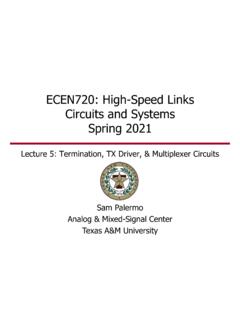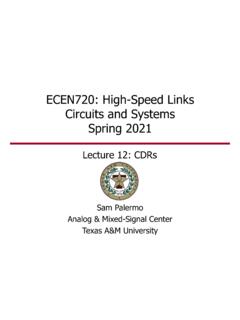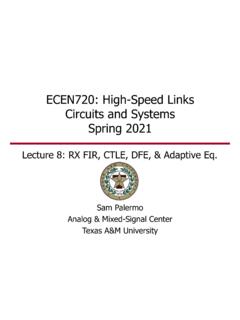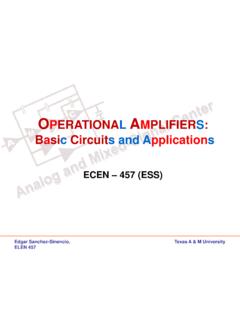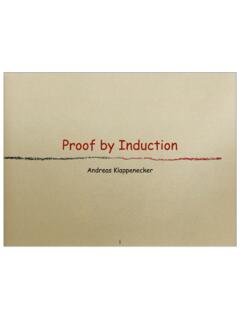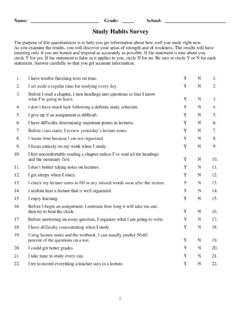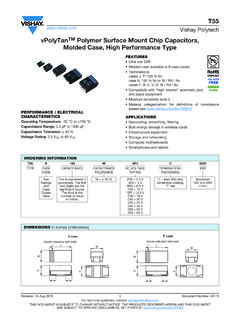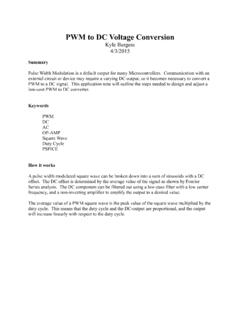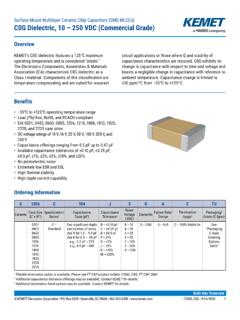Transcription of ECEN720: High-Speed Links Circuits and Systems Spring …
1 Sam PalermoAnalog & Mixed-Signal CenterTexas A&M UniversityECEN720: High-Speed Links Circuits and SystemsSpring 2023 Lecture 6: RX CircuitsAnnouncements Lab 4 report and Prelab 5 due Mar 6 Exam 1 Mar 7 Covers material through Lecture 6 Previous years exam 1s are posted on the website for reference Sampler and comparator papers are posted on the website2 Outline Receiver parameters T-coils at RX examples Analog front-end Clocked comparators Sensitivity & offset correction Demultiplexing PAM4 RX example3 High-Speed Electrical link System4 Receiver Parameters RX sensitivity, offsets in voltage and time domain, and aperture time are important parameters Minimum eye width is determined by aperture time plus peak-to-peak timing jitter Minimum eye height is determined by sensitivity plus peak-to-peak voltage offset5[Dally]
2 RX Block Diagram RX must sample the signal with high timing precision and resolve input data to logic levels with high sensitivity Input pre-amp can improve signal gain and improve input referred noise Can also be used for equalization, offset correction, and fix sampler common-mode Must provide gain at high -bandwidth corresponding to full data rate Comparator can be implemented with static amplifiers or clocked regenerative amplifiers Clocked regenerative amplifiers are more power efficient for high gain Decoder used for advanced modulation (PAM4, Duo-binary)6 Outline Receiver parameters T-coils at RX examples Analog front-end Clocked comparators Sensitivity & offset correction Demultiplexing PAM4 RX example756Gb/s PAM4 Input Network T-coil isolates ESD and input stage capacitance Shunt peaking with termination network provides bandwidth extension8[Pisati ISSCC 2019]100Gb/s PAM4 Input Network Bridged T-coil isolates ESD and provides further bandwidth extension Series peaking isolates input stage capacitance9[Loi ISSCC 2019]Outline Receiver parameters T-coils at RX examples Analog front-end Clocked comparators Sensitivity & offset correction Demultiplexing PAM4 RX example10 Analog Front-End (AFE)
3 AFE provides equalization (CTLE) and gain stages (VGA) to optimize the signal for symbol detection (mixed-signal RX) or quantization (ADC-based RX) Shrinking supply voltages make it difficult to efficiently achieve gain11[Pisati ISSCC 2019]RX Static Differential Amplifiers Differential input amplifiers often used as input stage in high performance serial Links Rejects common-mode noise Sets input common-mode for preceding comparator Input stage type (n or p) often set by termination scheme high gain-bandwidth product necessary to amplify full data rate signal Offset correction and equalization can be merged into the input amplifier12 LmoLmvRgrRgA111 3114331mmooommvgggggggA Low- voltage Gm-TIA Amplification Two-stage topology consisting of an input transconductance(Gm) stage followed by an output transimpedance (TIA)
4 Stage allows for low- voltage operation Both NMOS and PMOS transconductance can be utilized TIA stage allows for improved gain with better linearity, as mostly signal current passes through RF13[Pisati ISSCC 2019]eSilicon 56Gb/s PAM4 CTLE Gm-Stage Input AC-coupling for optimal common-mode to utilize both NMOS and PMOS Gm RC degeneration at main input transistors sources provides high -frequency peaking Additional tunable bias resistor at the NMOS input provides an additional zero for low-frequency channel compensation Gain control achieved through bias programmability 14[Pisati ISSCC 2019]eSilicon 56Gb/s PAM4 CTLE TIA-Stage Inverter-based gain stage with feedback resistor Supply noise rejection achieved with a replica-bias regulated power supply As mostly signal current flows through RF, good linearity is achieved with high signal swing 15[Pisati ISSCC 2019]Inverter-Based Design Inverter-based design allows for both NMOS and PMOS transconductance Cells can also be used as resistive and active-inductor loads16[Zheng CICC 2018]56Gb/s Inverter-Based CTLE Replica Bias Loop17[Zheng CICC 2018]
5 Replica-biasing with ring oscillator-based process monitorOutline Receiver parameters T-coils at RX examples Analog front-end Clocked comparators Sensitivity & offset correction Demultiplexing PAM4 RX example18RX Clocked Comparators19 Also called regenerative amplifier, sense-amplifier, flip-flop, latch Samples the continuous input at clock edges and resolves the differential to a binary 0 or 1[J. Kim]Important Comparator Characteristics Offset and hysteresis Sampling aperture, timing resolution, uncertainty window Regeneration gain, voltage sensitivity, metastability Random decision errors, input-referred noise20 Dynamic Comparator Circuits To form a flip-flop After strong-arm latch, cascade an R-S latch After CML latch, cascade another CML latch Strong-Arm flip-flop has the advantage of no static power dissipation and full CMOS output levels21 Strong-Arm LatchCML Latch[Toifl][J.]
6 Kim]StrongARM Latch Operation[J. Kim TCAS1 2009] 4 operating phases: reset, sampling, regeneration, and decision22[J. Kim]t=t0t1t2 StrongARM Latch Operation Sampling Phase[J. Kim TCAS1 2009]23 , where12211212221221moutsmxsssxoutmmxoutx outmxoutmminoutgCgCsCCsggCCCCgsCsCggsvsv Sampling phase starts when clk goes high , t0, and ends when PMOS transistors turn on, t1 M1 pair discharges X/X M2 pair discharges out+/-StrongARM Latch Operation Regeneration[J. Kim TCAS1 2009]24 rmrmoutRRRggCttG,3,212/exp Regeneration phase starts when PMOS transistors turn on, t1, until decision time, t2 Assume M1 is in linear region and circuit no longer sensitive to vin Cross-coupled inverters amplify signals via positive-feedback:25 StrongARM Latch Operation Diff.
7 Output[J. Kim TCAS1 2009] RS latch holds output data during latch pre-charge phase Conventional RS latch rising output transitions first, followed by falling transitionVcm- VConventional RS Latch261110010[Nickolic]Vcm+ VVcm- VVcm+ VOptimized RS Latch27 Optimizing RS latch for symmetric pull-up and pull-down paths allows for considerable speed -up During evaluation, large driver transistors are activated to change output data and the keeper path is disabled During pre-charge, large driver transistors are tri-stated and small keeper cross-coupled inverter activated to hold dataDriver BranchesKeeper Branches[Nikolic JSSC 2000]Evaluation Mode (Clock high )
8 Hold/Precharge Mode (Clock Low)Vcm- VVcm+ VVcm- VVcm+ V1010110 Delay Improvement w/ Optimized RS Latch28[Nikolic JSSC 2000] Strong-Arm flip-flop delay improves by close to a factor of two Has better delay performance than other advanced flip-flop topologiesSampler Analysis29 Sampler analysis provides insight into comparator operation dhvvinsample[Johansson JSSC 1998] h Switch can be modeled as a device which determines a weighted average over time of the input signal The weighting function is called the sampling functionSampling Function Properties30 Sampling function should (ideally) integrate to 1 1 dh Ideal sampling function is a delta function Sampled value is only a function of exact sampling time dhvvinsample th idealSampling Function Example31 Practical sampling function will weight the input signal near the nominal sampling time dhvvinsample h PracticalSampler Frequency Response32 Fourier transform of the sampling function yields the sampler frequency response Sampler bandwidth is a function of sample clock transition time hSampler Aperture Time33 Aperture time is defined as the width of the SF peak were a certain percentage (80%)
9 Of the sensitivity is confined h Clocked Comparator LTV Model34 Comparator can be viewed as a noisy nonlinear filter followed by an ideal sampler and slicer (comparator) Small-signal comparator response can be modeled with an ISF ,th [J. Kim]Clocked Comparator ISF Comparator ISF is a subset of a time-varying impulse response h(t, )for LTV Systems : h(t, ): system response at tto a unit impulse arriving at ISF ( )=h(tobs, ) For comparators, tobsis before decision is made Output voltage of comparator Comparator decision35 dxthty , dvtviobso dvkTtvvDiobsokksgnsgnsgnClocked Comparator ISF36 ISF is defined with respect to tobs, or the decision time The comparator provides the most gain during the sampling phase[J.]
10 Kim]Clocked Comparator ISF37 ISF shows sampling aperture or timing resolution In frequency domain, it shows sampling gain and bandwidth[J. Kim]Characterizing Comparator ISF38[Jeeradit VLSI 2008][Toifl][J. Kim]Strong-Arm LatchCML Latch For more details, see ~spalermo/ecen689 of SA & CML Comparator (1)39 Sampling time of SA latch varies with VDD, while CML isn t affected much[Jeeradit VLSI 2008]Comparison of SA & CML Comparator (2)40 CML latch has higher sampling gain with small input pair StrongARM latch has higher sampling bandwidth For CML latch increasing input pair also directly increases output capacitance For SA latch increasing input pair results in transconductanceincreasing faster than capacitance[Jeeradit VLSI 2008]Low- voltage SA Schinkel ISSCC 200741 Does require clk & clk_b How sensitive is it to skew?
